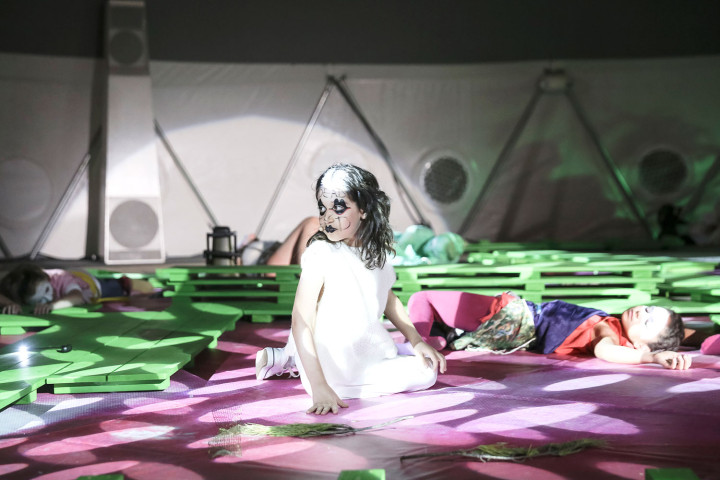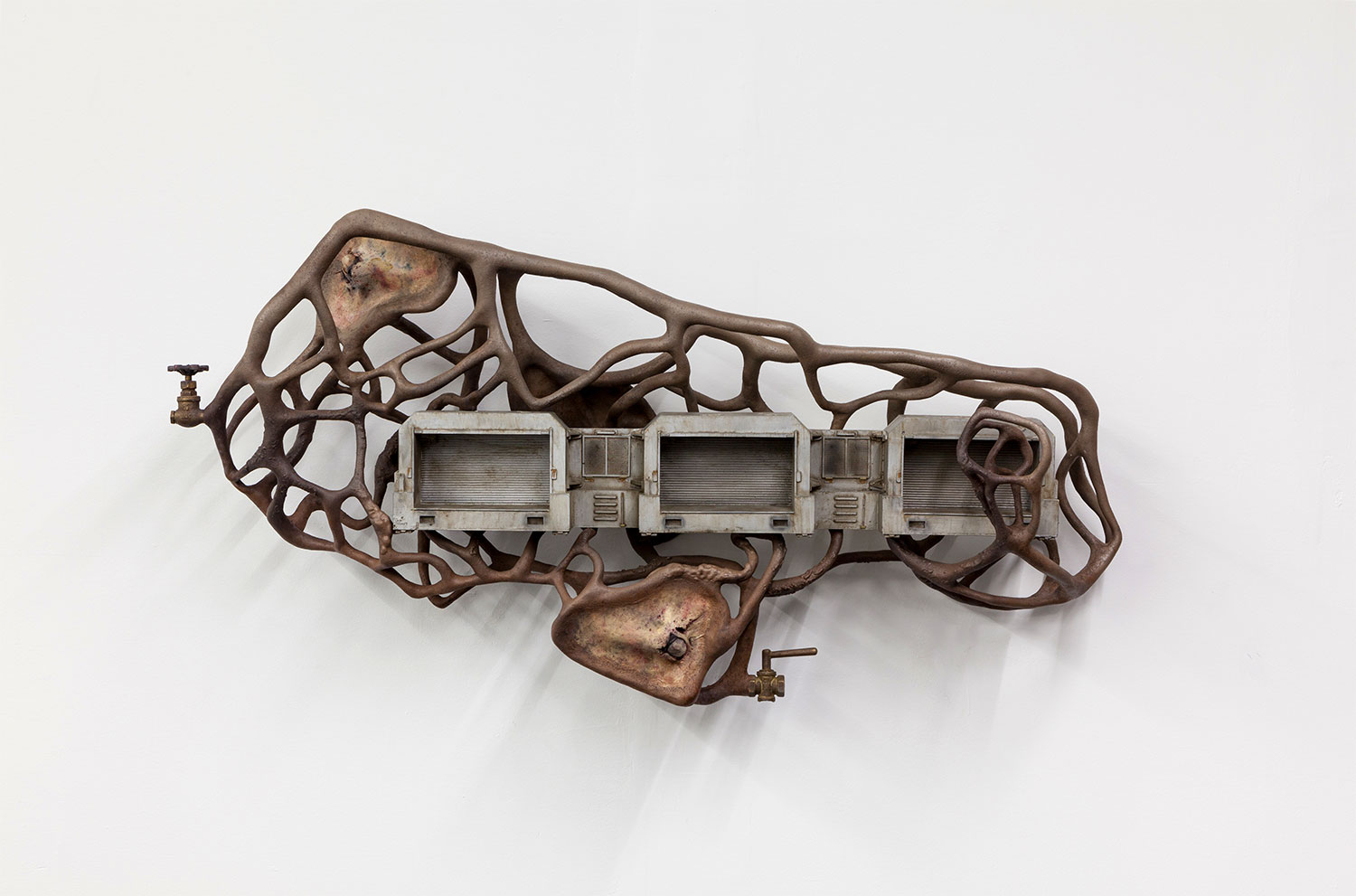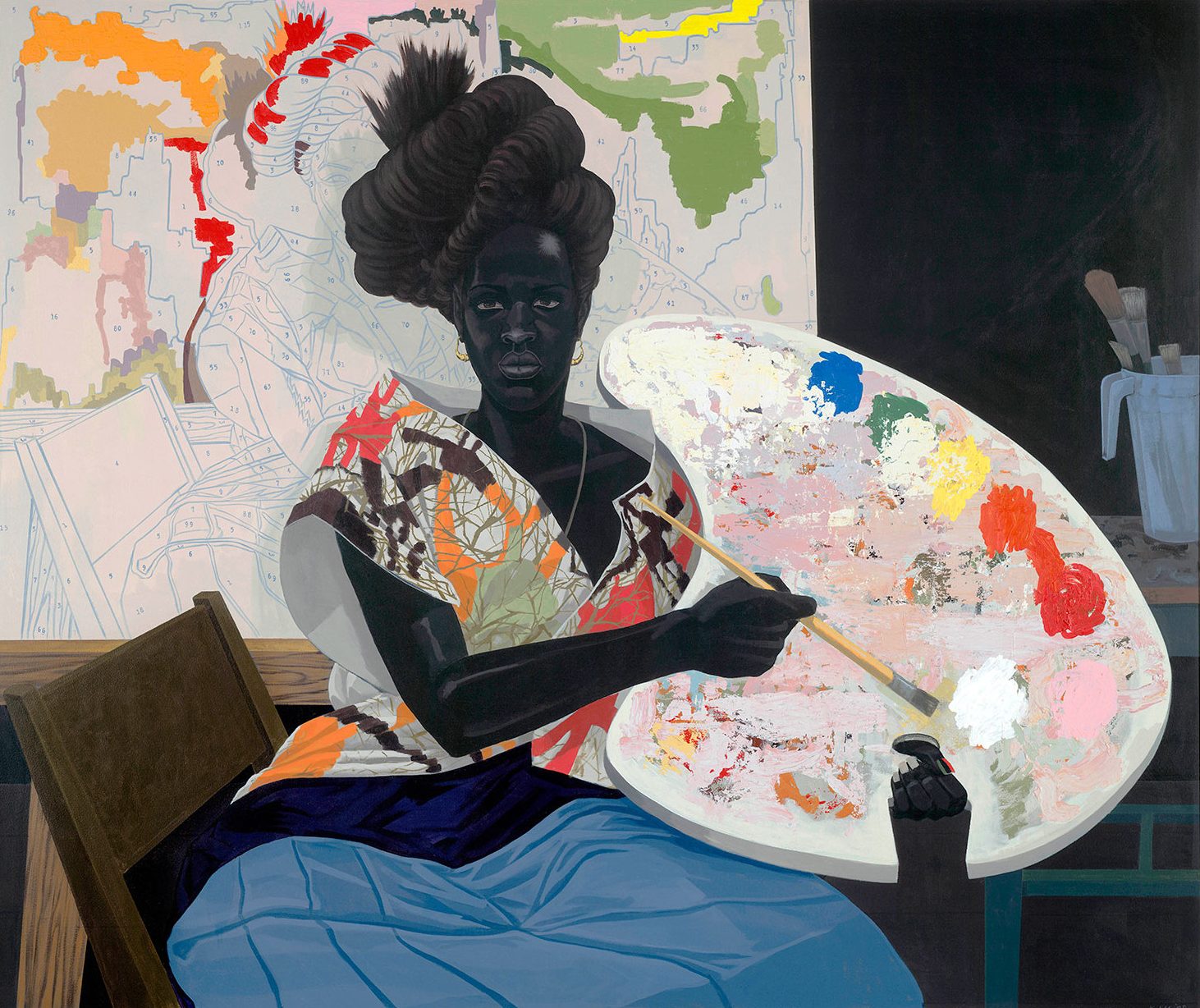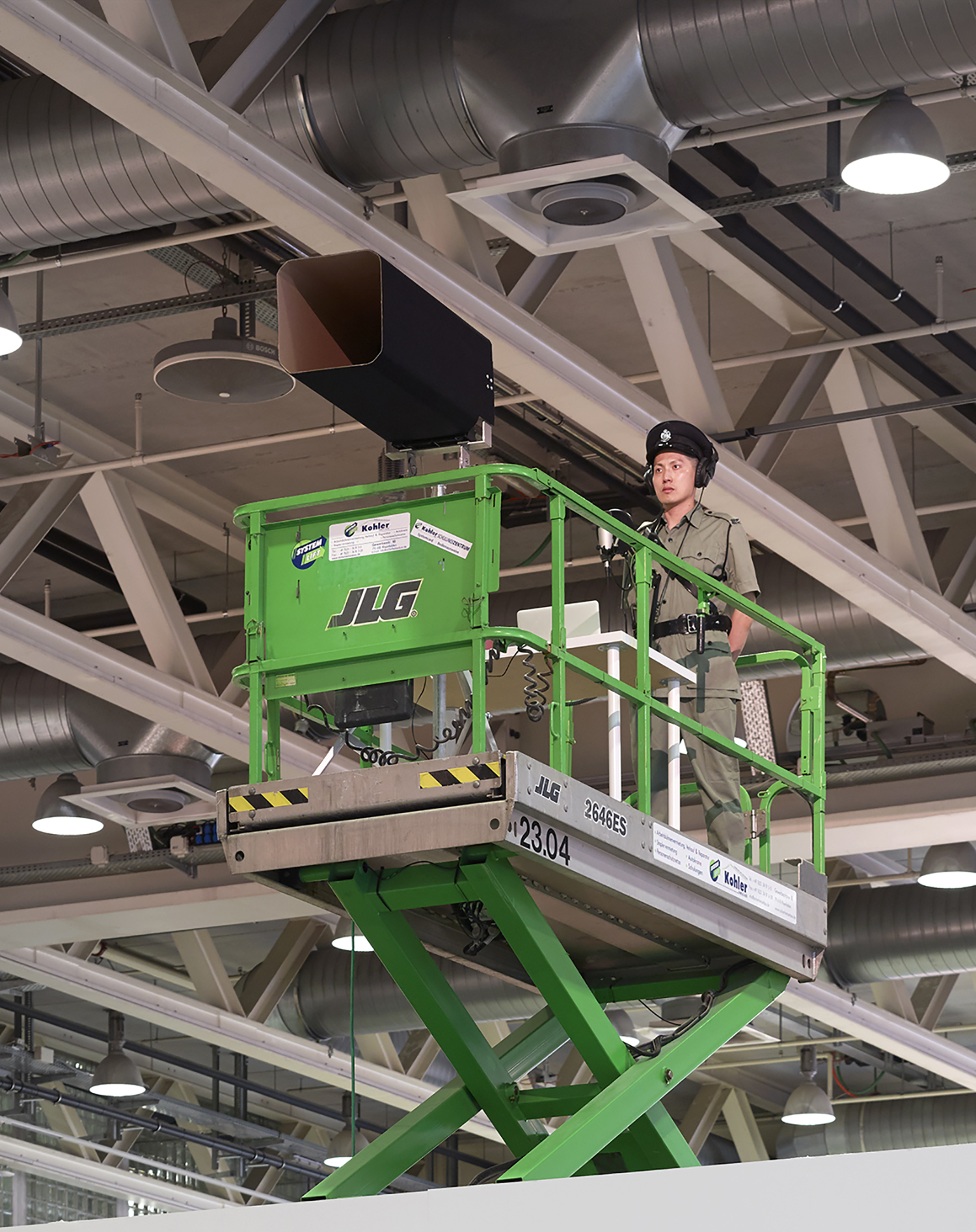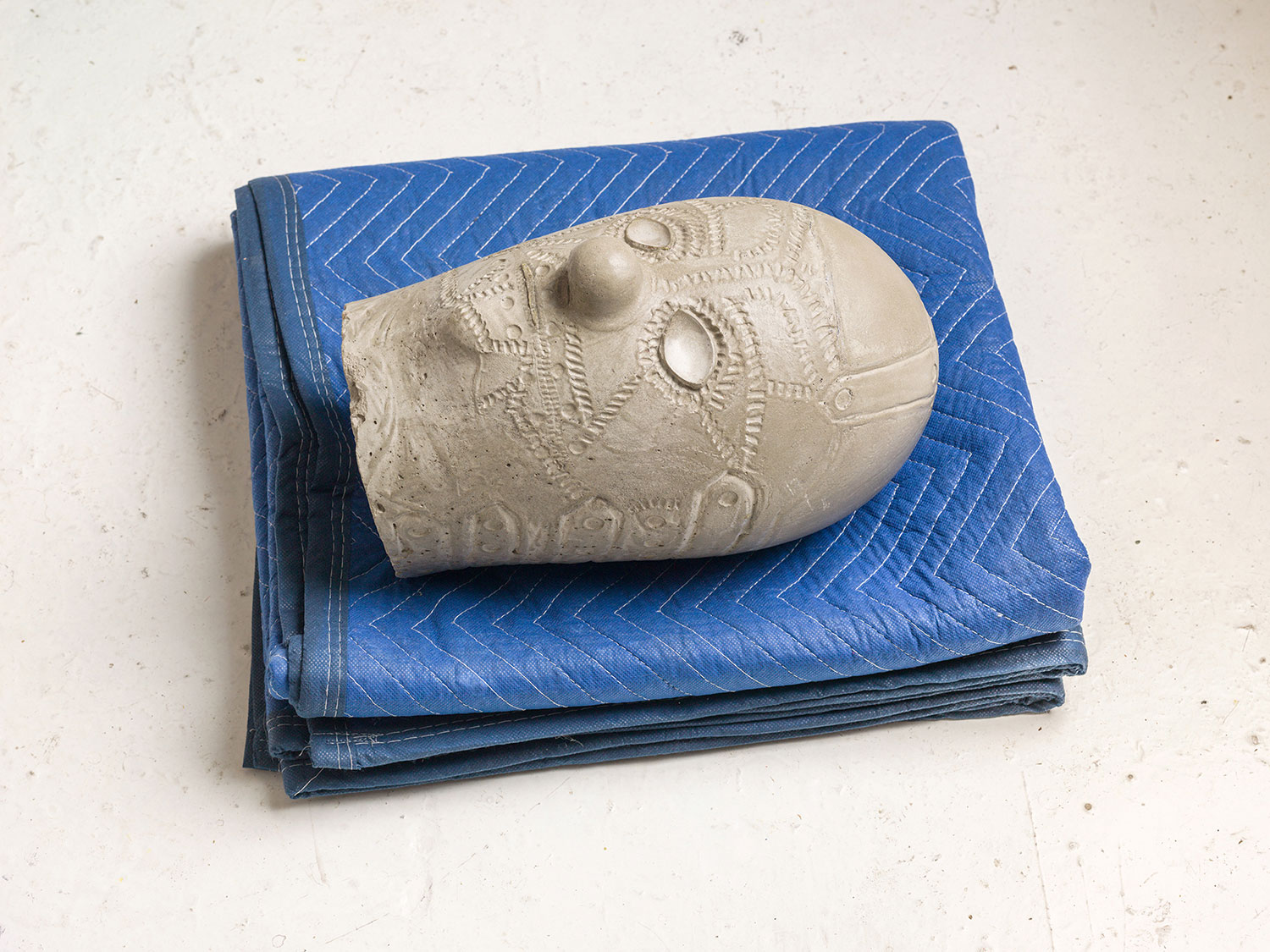
The practice of polymath Shūji Terayama (1935–1983) began with the poetry for which he first became known in his native Japan. However, it is the consequences of the collective as encountered in his films and plays that has framed and informed two collaborations by artists Matthew Lutz-Kinoy (b. 1984, US) and Tobias Madison (b. 1985, Switzerland), first at Kunsthalle Zurich last year and then this past spring at MoMA PS1, New York. Together, at least temporarily, three different histories of artist-initiated activity intersected, each of them occupied with how audiences assemble and engaging us with alternatives to the autonomy of the individual artist.
Jacob Korczynski: Tobias, from what I understand you first introduced Matthew to Terayama’s practice through a screening you organized at AP News in Zurich. Can you tell me how this early engagement with Terayama developed into the longer arc of research that has informed your collaborations with Matthew?
Tobias Madison: AP News was founded as a cinema and music venue in Zurich by a group of artists, musicians, writers and activists. Apart from other shared sensibilities, everybody had an interest in the Japanese avant-garde and in the social models that were implied by it. The space was even named after a monthly image spread called “APN” in the magazine Asahi Picture News. Generally I would say AP News was problem-oriented, as in not trying to come up with solutions, but embracing all the complications that come with working in groups. So that already somewhat parallels Terayama’s work. There were a lot of screenings of Japanese avant-garde films, and I discovered Terayama through a friend, Melanie Mermod, who organized one of the cycles.
Matthew and I traveled together in Japan, and I would always go to different archives for research. Matthew came along one day and had all these interesting things to say about performance documentation, and at one point he said: “Well, I guess in order to produce something interesting you gotta have an interesting life first.” I thought it was such an elitist thing to say, but then again, you can turn it around and it becomes pretty passable. There is a certain outrageousness in Terayama’s work — and I don’t mean the part where he breaks with societal conventions, but more his balance of being an incredibly abusive person, sucking all these people and their talents dry, and at the same time maintaining this incredibly generous and unresolved space. I don’t know, I like problems; solutions are so easily swallowed. Even Matthew’s and my work are so problematic when combined, they point in such opposite directions, and I think that’s what made us interested in working together on something. But it was not until the somewhat unorthodox invitation by the Kunsthalle Zurich a year later that we actually did. We just became really good friends in the meantime.

JK: Reading about Terayama’s practice I was struck by how he engaged with institutions in multiple ways. For example, his play Kegawa no Marii was performed at the Shinjuku Art Theater in 1967, and then, four years later, in 1971, his first feature-length film, Throw Out Your Books, Let’s Hit the Streets (which itself echoes Kegawa no Marii through a similar appearance by actor Akihiro Miwa) was screened in the same space. This made me think of your engagement with the Kunsthalle Zurich: first with your solo show there in 2013 and then working with Matthew there again two years later for the Theater der Überforderung project focused on Terayama. Did the collaborative conditions at work in the former project directly inform the dynamic of the latter?
TM: I think institutions are somewhat differently organized in Europe than in the US — they’re chaotic, understaffed and often artists work in them. So I think that’s why I’m still interested in working in them. The institutions in Japan during the ’60s and ’70s operated similarly, especially the Shinjuku Art Theater and the Sogetsu Art Center, which were both artist-run. My show at the Kunsthalle Zurich happened when Beatrix Ruf was still the director there, and I was running AP News at the same time. So I made an interrogation of the compatibility of the two, along with another space, a club night called House of Mixed Emotions, and the void that appears when you try to translate something into something else. It was a very conceptual show, with mathematical and economical models and with the works being somehow ruins of a feedback loop, the real activity displaced and the institution devoid of human presence, more like a ghost presence.
In a way, the project of Matthew and I was the opposite, ghosts still present though. I went to lunch with Daniel Baumann (with whom I had run the artist-run space New Jerseyy and who was now the director of the Kunsthalle) and Barbara Weber, a theater director in Zurich, and they were talking about a collaborative project and asked me for advice. So I told them about Terayama and about Matthew’s and my interest in him. And that’s how we all started working together.
It was one of the first projects that Daniel did at the Kunsthalle, and I think his program has been really interesting. He’s asking what a kunsthalle could be now, other than the extension of a market/language nexus, because he comes more from a freelance practice and also organizing as part of an artist-run space.
So I think my exhibition and the collaboration with Matthew were somehow related as they both dealt with a post-relational-aesthetics problem, with questions about autonomy being directed at the audience as well as the producers.

JK: In Terayama’s La Marie-Vision (1967), which was the point of departure for your collaboration Rotting Wood, the Dripping Word: Shūji Terayama’s Kegawa no Marii at PS1, the script concludes with the crew of the play itself, including the lighting operator, stage manager and stage hands, all unexpectedly entering the stage where they begin smearing lipstick and rouge on their faces. With Terayama’s troupe Tenjō Sajiki forming the base of his practice from 1967 to 1983, can you talk about your own group of collaborators that you assembled for the presentations in both Zurich and New York?
Matthew Lutz-Kinoy: Terayama’s productions lean towards visually strong endings where the entire crew of the production seems to be represented. I like that you bring up this makeup smear. In his film Throw Away Your Books, Rally in the Streets (1971), instead of credits there is a long black-and-white pan shot moving from right to left, of all the crew of the film, ending on Miwa and Terayama, while many of the plays conclude in a procession and not in a familiar theatrical bow. There are some remarkable core members of the group, like artist Yoko Ran, who we were able to meet through the assistance of the photographer Hanayo Nakajima of the Tenjō Sajiki group, who were in almost every single play and film that the group produced. However, the theater group consisted of over two thousand members over its sixteen years, and so our understanding of what it meant to envelop a group based around Terayama’s performative practice was expansive in that regard. We were able to work with many artists for the first time, and allowed for people to freely develop contributions in the performance alongside the director Ariel Efraim Ashbel, who elegantly synthesized dispersed ideas to make them durational.
JK: Through your work with Tobias around Terayama can you also speak to theater not only as material but also as methodology? In particular I’m thinking of the camaraderie of the collective that enables collaboration for the two of you — artists that primarily maintain individual practices. What are the political implications of working this way? Are the boundaries between on and off stage that easy to disturb?
MLK: I find that organizing performances brings forward a question and variation on the social structuring of skills, talent and symbols. There are two interesting things that stuck with me recently reading through excerpts from Terayama’s text The Labyrinth and the Dead Sea: My Theatre. “Dramaturgy means ‘making relationships.’ Dramatic encounters reject class consciousness and create mutually cooperative relationships, thereby organizing chance into collective consciousness. […] If hell is other people’s affairs, then drama is a pilgrimage of other peoples hells […] where self and others criss-cross.” Not only is making work collaboratively a type of temporal hell, but witnessing that material has its own ring in some circle. I think through the sharing of knowledge and the production of a shared performed space there is an opening that is created between people, which is also spoken of in regards to the production of theatrical space when Terayama states: “We must discard the idea of theaters as outward manifestations of physical reality and embrace the concept of theaters as aspects of inner reality.” I see this as the production of a space which is created though artistic collaborations.

JK: At the end of this text that Matthew just mentioned, Terayama offers only a tentative conclusion to the reader, stating that the theories about which he has written are not established in the abstract but rather are solely based upon the practical activities of the Tenjō Sajiki troupe. In Terayama’s theater there is a process that is imperative for the performer and a production of meaning that is primary for the collaborators. Is the possibility of change dependent upon the dynamic of the group or does Terayama’s work also offer us something else as individual audience members?
TM: I think that under neoliberal capitalism all images become consumables and language has a tendency to start operating like images too. The conditions for perception were once blurry, but they tend to become more and more the same for everyone, so there is a shift from something that relies on empathy and possible misunderstanding to something smoother, more efficient, more compatible.
Terayama was someone who understood this really early. Although under different conditions, his work was more directed as a critique of critique (the new left and their bureaucratic thinking). However, as much as he was an outspoken hater of the countryside, he still continued to be an agent of a progressive rural thinking — coming from Aomori, a region in northern Japan that is famous for its many myths and folklore. So he employed superstition in a collaborative practice, the myths being created ad hoc and in process, the collaborators’ personal backgrounds often being directly worked into their characters — that is if they even played characters and not themselves. That’s also why Terayama’s model is so radically different from other utopian 1960s communal models: its not seeking out community for the sake of balance and harmony, but more for an appreciation of chaos and disruption in the collective narrative. But, interestingly, his plays don’t have a postmodernist form — they’re fairly traditional, comedic and to a certain extent universally understandable while containing this radical thought.
So when you think about now, there is almost an explosion in dystopic fantasy production, a regressive model of thinking which people seek out to isolate themselves from the powerful forces of capitalism. It’s akin to when the arrival of printing techniques in the Baroque era created an inflation of information and then the fantasy novel was born. But now the commercially produced fantasy narratives always follow the same pattern: they are universally understandable and very normative. So I think there is a lot of potential in the fantasy narrative, but you somehow have to invent it differently. A theater production isn’t an existing script that you try to index with everybody’s bodies, but a potential that gets rerouted and rerouted until no one knows what we’re actually talking about right now, but somehow everybody knows. It’s like a secret code and we’re revealing a part of it to the audience while we’re still working on it.

JK: Both of you have long histories in artist-run spaces, spaces that you have either collaborated on or participated in. These are spaces that, like Tenjō Sajiki, are dependent upon the individual energies and ongoing engagement of artists to sustain themselves and also determine their duration. Can you talk about how this current in your practice — as well as in Terayama’s — guided your collaborations at the Kunsthalle Zurich and PS1?
MLK: Tenjō Sajiki legendarily formed as a grouping of runaways who quite literally took the instruction to escape the countryside, initiated from Terayama’s texts in Throw Away Your Books, Rally in the Streets, and the audition advert posters for the group called out to all misfit outcasts. Spaces like Basso, in Berlin’s early millennium, influenced how I understood a radical potential in the production of a social space centered around sharing artwork. I think an investigation into ways of being together is valuable, to bring awareness to alternative forms of historic representation for figures who promoted antiestablishment through form. I think, as much as that group was a host to experimentation, research and openness of expression among its members, it also allowed for our cluster of artists to participate in a type of legacy of that mode of production. Looking towards Terayama’s practice is a way to find solutions in today’s systems of presentation. It provided both answers and a way out.
JK: Since the two of you first came together around Terayama’s practice in Zurich, and prior to your collaboration in New York, his work has appeared in your own individual exhibitions. Tobias, your exhibition “das blut, im fruchtfleisch gerinnend beim birnenbiss at kestnergesellschaft” in Hannover took Terayama’s film Emperor Tomato Ketchup (1971) as a framework; and Matthew, your exhibition “Princess Pompom in the Villa of Flowers” at Mendes Wood DM in São Paulo featured on the invitation an image appropriated from the poster for Terayama’s film Fruits of Passion (1981). Will Terayama’s practice continue to persist in each of your own projects?
MLK: Terayama’s work can be very dreamy, the images in the films surreal and graphic. Digesting so much Terayama content over the last years of research — inevitably its forms and images resurface. I hope to continue this research in modes of developing live works with Tobias. I think there is so much space for developing our relationship to this luscious material.
TM: Most likely. I mean, I’m not sure if Terayama is going to be such a direct reference — there is always the issue of fetishization. But the methodology and the way he thinks about social space have had a deep impact on me. I think about politics in a similar way, especially personal ones. Some models work for a while; autonomy is something that is always temporary. Then you abandon them and maybe come back to them, maybe you won’t, but they’re internalized.

